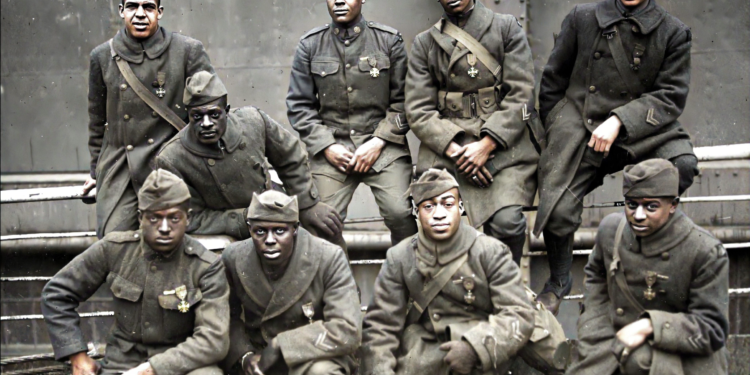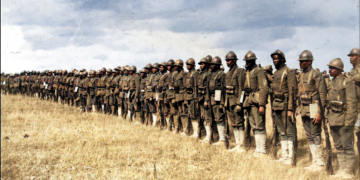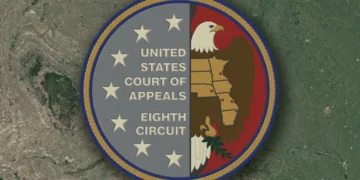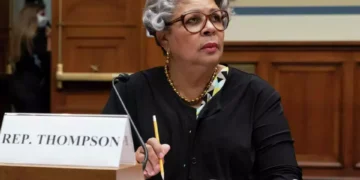June 30, 2025 Story by: Editor
A study from Harvard Kennedy School researchers has produced the most comprehensive quantitative analysis to date on how U.S. military service in World War I influenced postwar civil rights activism among African Americans. The work by economist Desmond Ang and doctoral student Sahil Chinoy draws from extensive archival data to measure how wartime discrimination increased political engagement—especially within the NAACP.

Photo caption: African American men line up to enlist at the Colored Y.M.C.A. in Des Moines, Iowa, for the Negro Officers’ Training Camp during World War I. Seated at the table is A. Merrill Willis, the first man to enlist. Fort Des Moines became the site of the first U.S. Army officer training program for African Americans in 1917. (Photo courtesy of: National Archives, Local Identifier 165-WW-127-121.)
Key Demographics and Military Composition
- Total African Americans in WWI service: 370,000–400,000 (approx. 13% of the total U.S. forces).
- Training restrictions: The majority were assigned to labor battalions, not combat. Only 10% received combat roles.
- 92nd Division: A segregated combat division subjected to both German fire and racist policies by U.S. officers.
- 93rd Division: Assigned to the French Army, where racial discrimination was significantly reduced. These units performed with distinction.
Black men who were induced to enlist were three times more likely to join the NAACP, the study found. Since the early 1800s, Black Americans had been barred from serving in the military and attending institutions such as West Point and the U.S. Naval Academy. When World War I broke out, the U.S. needed to beef up its defensive ranks quickly, so in 1917 it instituted the first nationwide draft of Black men, conscripting nearly 400,000. The move was unpopular, particularly within the all-white armed forces, and Black and white servicemen were segregated. Nearly 90 percent of Black troops were assigned labor-intensive or menial jobs, say the researchers, and most were denied combat and officer training, firearms, and promotions.
Institutional Discrimination Indicators
- Promotion Denial: Black soldiers were systematically denied officer status; the Army issued only a few hundred commissions to African Americans out of thousands of applicants.
- Training Facilities: Many Black recruits were sent to Southern camps where they faced rigid Jim Crow regulations.
- Letters and Complaints: Government archives contain numerous letters from Black soldiers citing mistreatment by commanding officers and lack of basic equipment.

Photo caption: Members of the 369th Infantry Regiment in France during World War I, equipped with French Adrian helmets issued while serving under French command. The 369th, an African American unit, earned high distinction for their frontline service and were among the most decorated U.S. troops of the war. (Photo courtesy of: National Archives, Local Identifier 165-WW-127-4.)
Postwar Civil Rights Engagement
Using cross-referenced data from the 1930 U.S. Census, state-level veterans’ surveys, and NAACP membership rolls:
- NAACP Membership Impact: Black veterans were 3x more likely to join the NAACP than non-veterans.
- In 1930, veterans made up 15% of all Black male members.
- Membership was highest in counties where veterans had served in racially discriminatory environments during training or deployment.
- State Surveys: Collected by 39 states after WWI.
- Veterans exposed to discriminatory conditions were 2x more likely to report grievances related to racial injustice in open-ended responses.
- Those in Southern camps or labor battalions disproportionately mentioned segregation and unequal treatment.

Photo caption: Members of a U.S. Army Hospital Corps detachment pose for a photograph prior to overseas deployment during World War I. Medical units like these played a critical support role, often serving under difficult and hazardous conditions near the front lines. (Photo courtesy of: National Archives, Local Identifier 165-WW-127-15.)
Intelligence and Surveillance
- The U.S. Military Intelligence Division (MID) monitored Black communities and veterans after the war.
- Reports noted increased circulation of political pamphlets, union literature, and civil rights organizing activity.
- Black newspapers such as The Chicago Defender and Pittsburgh Courier published accounts of returning soldiers challenging segregation and lynching.
Political and Structural Outcomes
- Civic leadership pipeline: Many veterans took leadership roles in NAACP branches, Black churches, fraternal orders (e.g., Prince Hall Masons), and labor unions.
- Policy initiatives: Their activism contributed to early civil rights lawsuits, voter registration efforts, and anti-lynching campaigns throughout the 1920s–30s.
- Backlash: Their visibility prompted increased Ku Klux Klan activity and state-level crackdowns on Black assembly, particularly in the South.

Photo caption: Members of the 367th Regiment, the “Buffaloes,” are presented with their colors in front of the Union League Club, New York City. (Photograph courtesy of the U.S. Army Signal Corps. From the World War I Signal Corps Collection, Record Group 165, National Archives and Records Administration. Local Identifier: 165-WW-127-87.)
Methodological Rigor
Ang and Chinoy’s methodology includes:
- Matching military service data with individual census records and death certificates.
- Comparing regions with high WWI Black veteran populations against NAACP expansion metrics.
- Controlling for confounding variables such as local economic conditions, education rates, and prewar Black population density.
Historical Significance
The researchers emphasize that these findings establish a causal link—not just a correlation—between racialized military service and increased political mobilization. This reinforces the view that unequal treatment under federal authority was a key driver of early 20th-century Black political organizing.
Source: Harvard Gazette

















